Online platforms play a crucial role in artist discovery by offering innovative tools and features that connect musicians with their audiences. By leveraging algorithms and community engagement, these platforms enhance user experience, tailoring content to individual preferences and promoting emerging talent. When choosing a music platform, it’s essential to consider features that support artist promotion and audience engagement to effectively reach listeners.
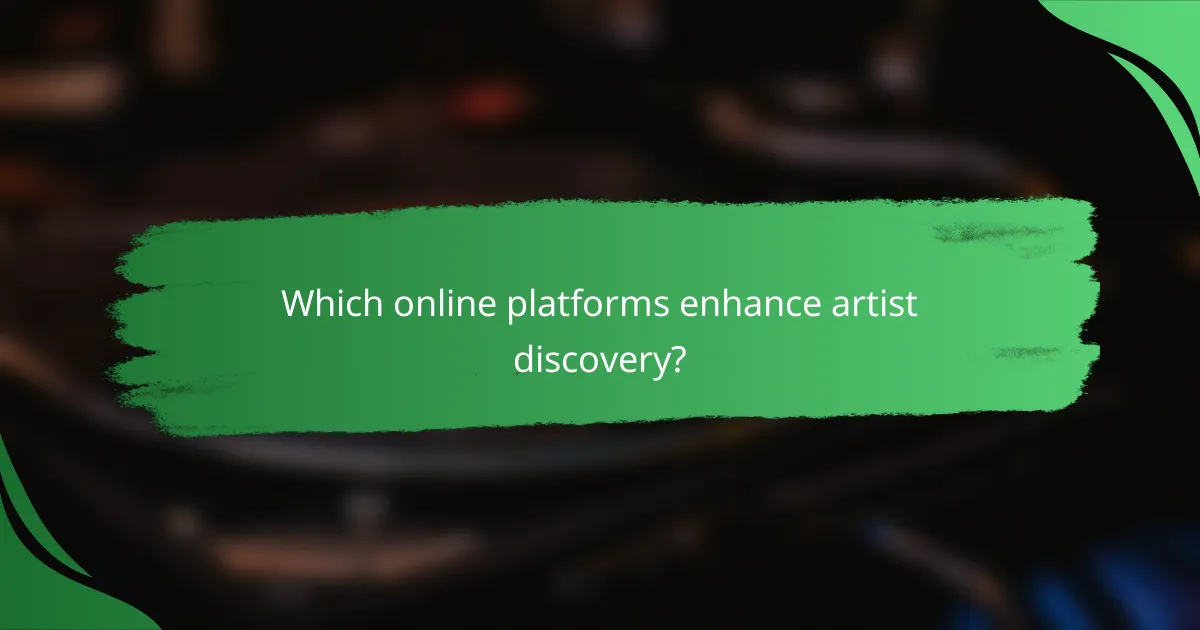
Which online platforms enhance artist discovery?
Several online platforms significantly enhance artist discovery by providing tools and features that connect musicians with listeners. These platforms utilize algorithms, user-generated content, and community engagement to promote emerging talent and facilitate music exploration.
Spotify for Artists
Spotify for Artists offers musicians insights into their audience and performance metrics, helping them tailor their marketing strategies. The platform allows artists to submit their music for playlist consideration, which can dramatically increase visibility. Engaging with fans through Spotify’s Canvas feature and social media integration can further enhance discovery.
SoundCloud
SoundCloud is known for its user-generated content and community-driven approach, making it a popular choice for independent artists. The platform allows users to upload tracks and interact directly with listeners, fostering a sense of community. Artists can leverage tags and genres to improve their discoverability and participate in collaborations to reach wider audiences.
Bandcamp
Bandcamp empowers artists by allowing them to sell their music directly to fans, often at prices they set themselves. This platform emphasizes artist control and fan engagement, encouraging listeners to support their favorite musicians. Bandcamp’s discovery features, such as curated collections and genre tags, help users find new music that aligns with their tastes.
Apple Music
Apple Music provides a curated experience, featuring playlists and radio shows that highlight new and emerging artists. The platform’s algorithm suggests music based on user preferences, enhancing the chances of discovery. Artists can benefit from promotional opportunities through features like “New Music Daily” and curated playlists, which can lead to increased streams and fan engagement.
Deezer
Deezer offers personalized recommendations and curated playlists that help users discover new artists based on their listening habits. The platform’s “Flow” feature provides a continuous stream of music tailored to individual tastes, making it easier for listeners to find emerging talent. Artists can promote their work through Deezer’s editorial playlists and social media sharing options, boosting their visibility.
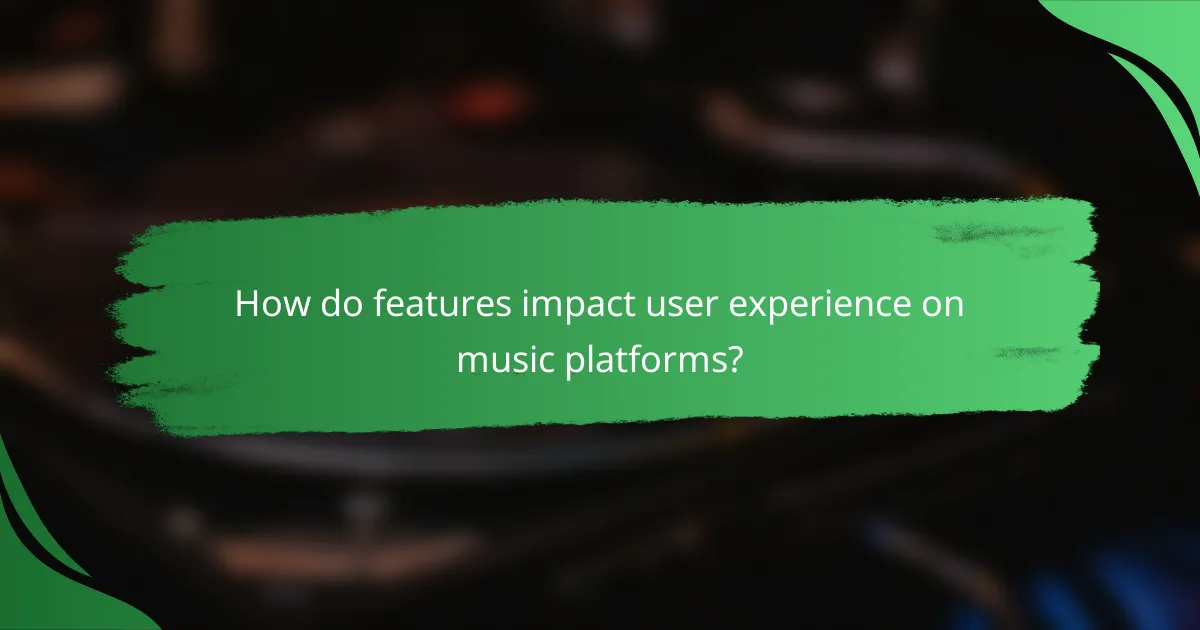
How do features impact user experience on music platforms?
Features significantly enhance user experience on music platforms by tailoring content to individual preferences, simplifying navigation, and fostering community engagement. These elements not only improve satisfaction but also encourage longer listening sessions and increased platform loyalty.
Personalized playlists
Personalized playlists are a key feature that music platforms use to enhance user experience. By analyzing listening habits and preferences, platforms can create tailored playlists that introduce users to new music they are likely to enjoy. This customization can lead to higher engagement and satisfaction, as users feel the platform understands their tastes.
For example, platforms like Spotify and Apple Music offer weekly curated playlists that adapt based on user interactions. Users should regularly update their listening preferences to ensure the playlists remain relevant and enjoyable.
User-friendly interfaces
A user-friendly interface is crucial for a positive experience on music platforms. Intuitive navigation, clear categorization, and responsive design help users find their favorite songs and discover new artists with ease. A well-designed interface minimizes frustration and encourages exploration.
Consider platforms that prioritize simplicity, such as YouTube Music, which offers straightforward access to playlists and recommendations. Users should look for platforms that allow easy customization of their home screens to suit their listening habits.
Social sharing options
Social sharing options enhance user experience by allowing users to connect with friends and share their favorite tracks or playlists. This feature fosters a sense of community and encourages users to explore music that their peers enjoy. Platforms that integrate social media sharing can amplify user engagement.
For instance, platforms like SoundCloud enable users to share tracks directly on social media, increasing exposure for both the artist and the user. Users should take advantage of these features to discover music through their social networks.
High-quality audio streaming
High-quality audio streaming is essential for an optimal listening experience. Many users prefer platforms that offer lossless audio formats or higher bitrates, which provide clearer sound and a more immersive experience. This feature is particularly important for audiophiles and those who appreciate intricate musical details.
Platforms like Tidal and Qobuz cater to this demand by offering high-fidelity audio options. Users should consider their audio preferences and equipment when choosing a platform, as the quality of streaming can significantly impact enjoyment.
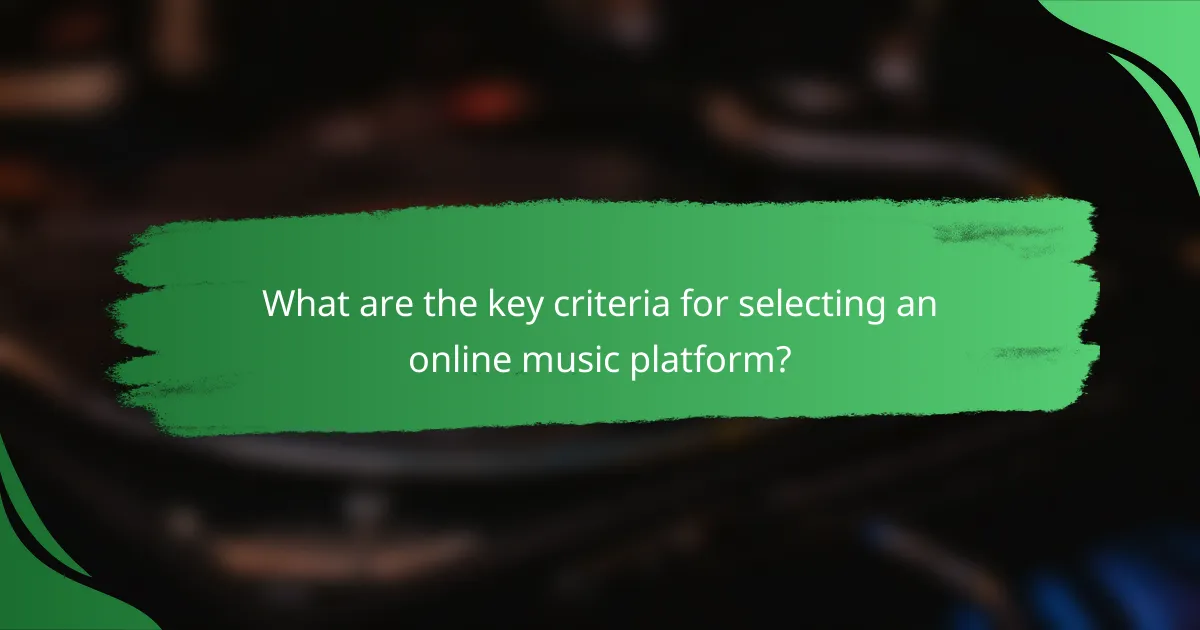
What are the key criteria for selecting an online music platform?
When selecting an online music platform, consider the features that support artist promotion, monetization options, and audience engagement. These criteria help ensure that the platform aligns with your goals as an artist and enhances your ability to reach and connect with listeners.
Artist promotion tools
Artist promotion tools are essential for increasing visibility and attracting new listeners. Look for platforms that offer features such as social media integration, customizable artist profiles, and targeted advertising options. Some platforms may also provide analytics to track the effectiveness of your promotional efforts.
For example, platforms like Spotify and SoundCloud allow artists to share their music easily on social media, while Bandcamp offers tools for email marketing to engage with fans directly. Evaluate the ease of use and effectiveness of these tools to maximize your promotional reach.
Monetization options
Monetization options vary significantly between online music platforms, impacting how artists earn revenue. Consider platforms that offer multiple income streams, such as streaming royalties, merchandise sales, and fan subscriptions. This diversity can provide more financial stability.
For instance, platforms like Patreon allow fans to support artists through monthly subscriptions, while others like Apple Music pay artists based on streams. Research the payout structures and fees associated with each platform to ensure you choose one that aligns with your financial goals.
Audience engagement features
Audience engagement features are crucial for building a loyal fanbase. Look for platforms that facilitate direct interaction with listeners through comments, live streaming, or Q&A sessions. These features help create a sense of community and encourage fan loyalty.
Platforms such as YouTube and Twitch excel in audience engagement, offering live chat during streams and interactive content. Assess how these features can enhance your connection with fans and consider how often you can engage with your audience to maintain interest and support.
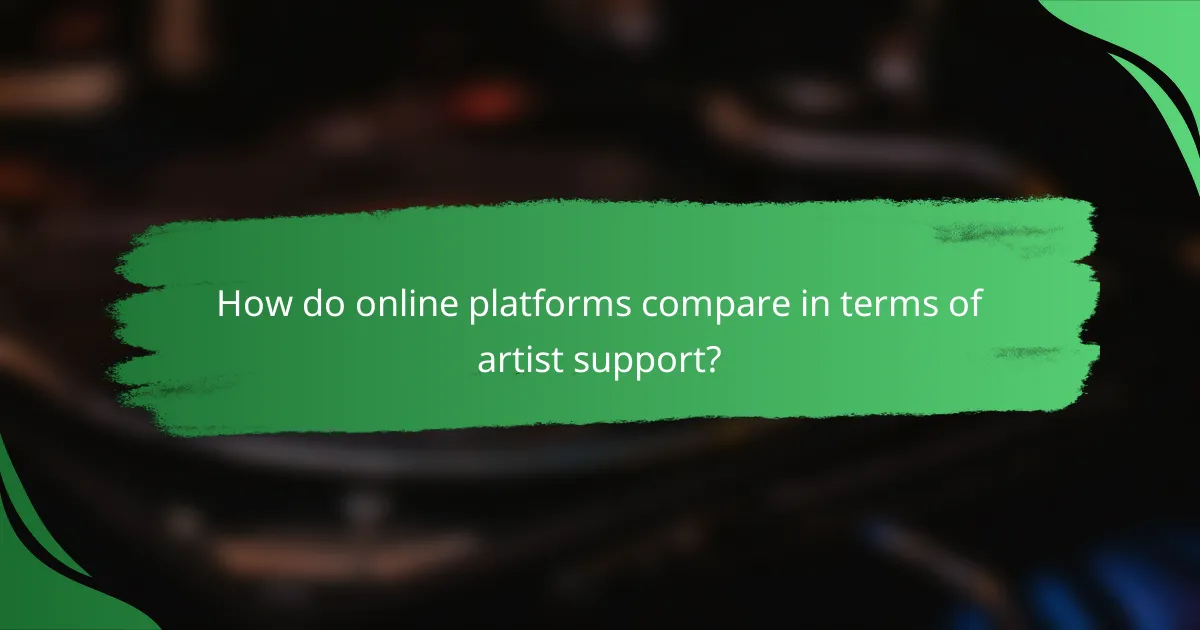
How do online platforms compare in terms of artist support?
Online platforms vary significantly in their artist support, focusing on different aspects such as revenue sharing, analytics, and community engagement. Understanding these differences can help artists choose the best platform for their needs.
Revenue sharing models
Revenue sharing models determine how much money artists earn from their work on a platform. Most platforms take a percentage of the revenue generated, typically ranging from 15% to 30%. Artists should evaluate these percentages alongside any additional fees that may apply.
Some platforms offer tiered models, where the percentage decreases as an artist’s earnings increase, providing more incentive for successful creators. It’s crucial to read the fine print to understand how these models impact overall earnings.
Analytics and insights
Analytics and insights are essential for artists to understand their audience and improve their content. Many platforms provide detailed metrics, such as listener demographics, engagement rates, and revenue breakdowns. These insights can guide artists in tailoring their marketing strategies and content creation.
Platforms that offer real-time analytics allow artists to make quick adjustments to their approach, while others may provide monthly summaries. Artists should choose platforms that align with their need for data to enhance their growth and visibility.
Community building
Community building features help artists connect with their audience and foster loyalty. Platforms that prioritize community often include tools for direct interaction, such as comments, forums, or live events. Engaging with fans can lead to stronger support and increased visibility.
Artists should look for platforms that facilitate collaboration with other creators, as this can expand their reach and introduce them to new audiences. Building a community around their work can significantly enhance an artist’s career trajectory.
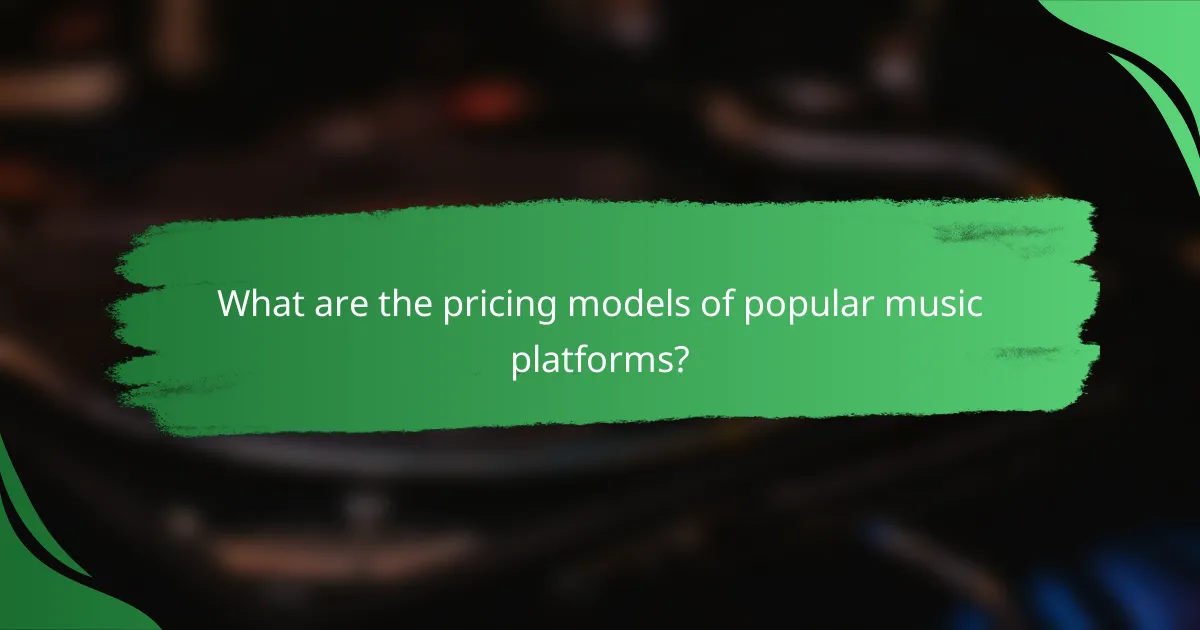
What are the pricing models of popular music platforms?
Popular music platforms typically utilize a combination of subscription fees, commission rates, and options for free or premium access. Understanding these pricing models can help artists and users make informed decisions about which platform best suits their needs.
Subscription fees
Subscription fees are a common pricing model for music streaming services, allowing users to access a vast library of music for a monthly fee. These fees generally range from around $5 to $15 per month, depending on the service and the type of plan chosen, such as individual, family, or student plans.
For example, platforms like Spotify and Apple Music offer tiered subscription options, often providing discounts for students or families. Users should consider how often they listen to music and whether they prefer ad-free experiences when evaluating subscription costs.
Commission rates
Commission rates apply primarily to artists and creators who distribute their music through platforms. Most streaming services take a percentage of the revenue generated from streams, which can range from 15% to 30%. This means that artists should be aware of how much they will earn per stream after the platform’s cut.
For instance, if a platform charges a 30% commission, an artist would receive 70% of the revenue from their music sales or streams. Artists should compare commission rates across platforms to maximize their earnings.
Free vs. premium options
Many music platforms offer both free and premium options, allowing users to choose based on their preferences and budget. Free versions typically include ads and limited features, while premium subscriptions provide an ad-free experience and additional functionalities like offline listening.
For example, services like SoundCloud and Spotify provide free access with ads, while their premium versions offer enhanced features for a monthly fee. Users should weigh the benefits of premium features against the cost to determine if upgrading is worthwhile for their listening habits.
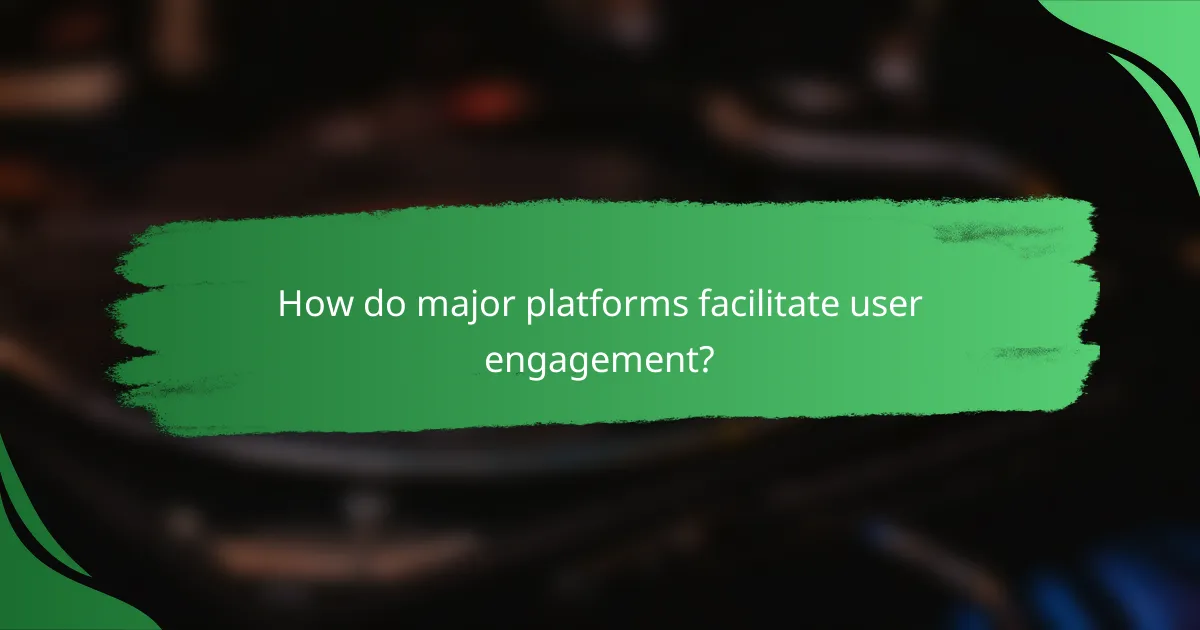
How do major platforms facilitate user engagement?
Major online platforms enhance user engagement through interactive features, personalized content, and community-building tools. These elements create a dynamic environment where users can connect, share, and discover new content tailored to their interests.
Interactive Features
Interactive features such as live chats, polls, and comment sections allow users to actively participate in discussions. This engagement fosters a sense of community and encourages users to return frequently. For instance, platforms like Twitch utilize live streaming and real-time chat to keep audiences engaged during broadcasts.
Additionally, gamification elements like badges, rewards, and leaderboards can motivate users to interact more with the platform. These features create a competitive yet fun atmosphere that can significantly increase user retention.
Personalized Content
Personalized content recommendations based on user behavior and preferences are crucial for maintaining engagement. Algorithms analyze user interactions to suggest relevant music, videos, or articles, making the experience more enjoyable and tailored. For example, Spotify uses listening history to curate personalized playlists.
Users are more likely to engage with content that resonates with their tastes, leading to longer session times and increased satisfaction. Regular updates to these algorithms help ensure that recommendations remain fresh and relevant.
Community-Building Tools
Community-building tools such as forums, groups, and social sharing options enable users to connect with like-minded individuals. These tools facilitate discussions and collaborations, enhancing the overall user experience. Platforms like Facebook and Reddit thrive on these community aspects, allowing users to form connections based on shared interests.
Encouraging user-generated content can also strengthen community ties. Platforms that allow users to create and share their content often see higher engagement levels, as users feel a sense of ownership and investment in the platform.

